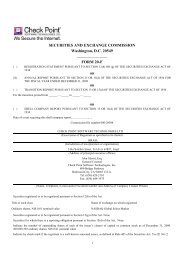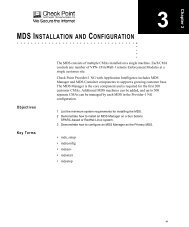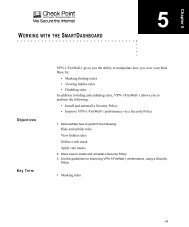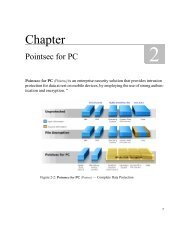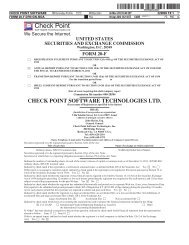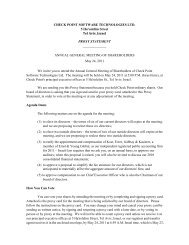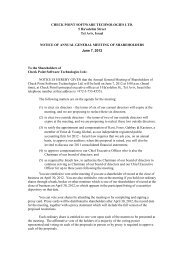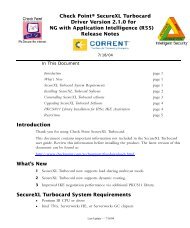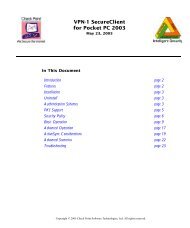You also want an ePaper? Increase the reach of your titles
YUMPU automatically turns print PDFs into web optimized ePapers that Google loves.
Command syntax<br />
<strong>fw</strong> moni<strong>to</strong>r [-u|s] [-i] [-d] [-D] [-l len] [-m<br />
mask] [-x offset[,len]] [-o ] [-a] [-ci count] [-co count] [-vs vsid or vsname]<br />
Figure 1: <strong>fw</strong> moni<strong>to</strong>r command line options<br />
Break Sequence<br />
Use ^C (that is Control + C) <strong>to</strong> s<strong>to</strong>p <strong>fw</strong> moni<strong>to</strong>r from capturing packets.<br />
Printing the UUID or the SUUID [-u|s]<br />
The option –u or –s is <strong>use</strong>d <strong>to</strong> print UUIDs or SUUIDs for every packet. Please note that it is only<br />
possible <strong>to</strong> print the UUID or the SUUID – not both. Please refer <strong>to</strong> Using UUIDs and SSIDs for further<br />
information.<br />
Flush standard output [-i]<br />
Use –i <strong>to</strong> make sure that captured data for each packet is at once written <strong>to</strong> standard output. This is<br />
especially <strong>use</strong>ful if you want <strong>to</strong> kill a running <strong>fw</strong> moni<strong>to</strong>r process and want <strong>to</strong> be sure that all data is<br />
written <strong>to</strong> a file.<br />
Debugging <strong>fw</strong> moni<strong>to</strong>r [-d] / [-D]<br />
The –d option is <strong>use</strong>d <strong>to</strong> start <strong>fw</strong> moni<strong>to</strong>r in debug mode. This will give you an insight in<strong>to</strong> <strong>fw</strong><br />
moni<strong>to</strong>r’s inner workings although this option is only rarely <strong>use</strong>d outside Check Point. It’s also possible<br />
<strong>to</strong> <strong>use</strong> –D <strong>to</strong> create an even more verbose output.<br />
Filter <strong>fw</strong> moni<strong>to</strong>r packets <br />
<strong>fw</strong> moni<strong>to</strong>r has the ability <strong>to</strong> capture only packets in which you are interested in. It is possible <strong>to</strong> set the<br />
filter expression on the command line (using the –e switch), read it from a file (-f) or <strong>to</strong> read it from<br />
standard input (-f -). Please refer <strong>to</strong> <strong>fw</strong> moni<strong>to</strong>r filters for a detailed description of the filter syntax.<br />
In the following examples we are filtering for the 9 th byte of the IP Header (‘accept [9:1]=1;’). The<br />
9 th byte is the IP pro<strong>to</strong>col and we are only accepting IP protcol 1 which is ICMP.<br />
Bas<br />
! When using filter expressions on the command line (using –e) you should make sure that they are<br />
properly quoted. On Windows and UNIX Operating systems this can be done by surrounding the<br />
expression with single quote (' – ASCII Value 39) or double quotes (" – ASCII Value 34). Please<br />
note that depending on your operating system and shell <strong>use</strong>d there might be differences between<br />
the two forms – especially when using special characters or (shell) variables in the filter expression.<br />
<strong>How</strong> <strong>to</strong> <strong>use</strong> <strong>fw</strong> moni<strong>to</strong>r Page 7 of 70<br />
Revision: 1.01



